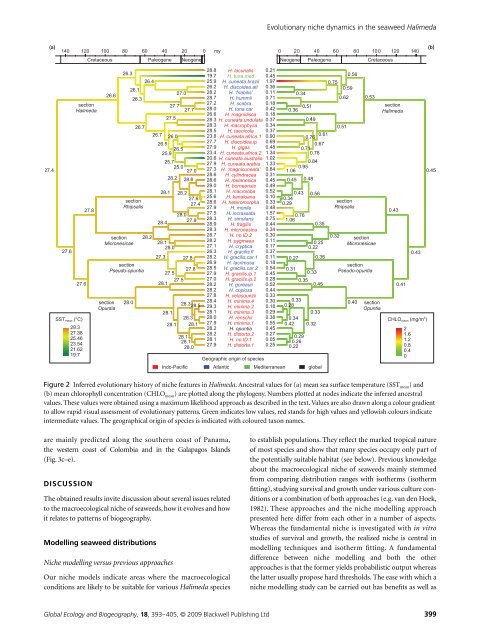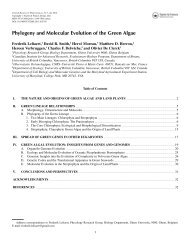Global Ecology and Biogeography - Phycology Research Group ...
Global Ecology and Biogeography - Phycology Research Group ...
Global Ecology and Biogeography - Phycology Research Group ...
You also want an ePaper? Increase the reach of your titles
YUMPU automatically turns print PDFs into web optimized ePapers that Google loves.
Evolutionary niche dynamics in the seaweed Halimeda<br />
Figure 2 Inferred evolutionary history of niche features in Halimeda. Ancestral values for (a) mean sea surface temperature (SST mean ) <strong>and</strong><br />
(b) mean chlorophyll concentration (CHLO mean ) are plotted along the phylogeny. Numbers plotted at nodes indicate the inferred ancestral<br />
values. These values were obtained using a maximum likelihood approach as described in the text. Values are also drawn along a colour gradient<br />
to allow rapid visual assessment of evolutionary patterns. Green indicates low values, red st<strong>and</strong>s for high values <strong>and</strong> yellowish colours indicate<br />
intermediate values. The geographical origin of species is indicated with coloured taxon names.<br />
are mainly predicted along the southern coast of Panama,<br />
the western coast of Colombia <strong>and</strong> in the Galapagos Isl<strong>and</strong>s<br />
(Fig. 3c–e).<br />
DISCUSSION<br />
The obtained results invite discussion about several issues related<br />
to the macroecological niche of seaweeds, how it evolves <strong>and</strong> how<br />
it relates to patterns of biogeography.<br />
Modelling seaweed distributions<br />
Niche modelling versus previous approaches<br />
Our niche models indicate areas where the macroecological<br />
conditions are likely to be suitable for various Halimeda species<br />
to establish populations. They reflect the marked tropical nature<br />
of most species <strong>and</strong> show that many species occupy only part of<br />
the potentially suitable habitat (see below). Previous knowledge<br />
about the macroecological niche of seaweeds mainly stemmed<br />
from comparing distribution ranges with isotherms (isotherm<br />
fitting), studying survival <strong>and</strong> growth under various culture conditions<br />
or a combination of both approaches (e.g. van den Hoek,<br />
1982). These approaches <strong>and</strong> the niche modelling approach<br />
presented here differ from each other in a number of aspects.<br />
Whereas the fundamental niche is investigated with in vitro<br />
studies of survival <strong>and</strong> growth, the realized niche is central in<br />
modelling techniques <strong>and</strong> isotherm fitting. A fundamental<br />
difference between niche modelling <strong>and</strong> both the other<br />
approaches is that the former yields probabilistic output whereas<br />
the latter usually propose hard thresholds. The ease with which a<br />
niche modelling study can be carried out has benefits as well as<br />
<strong>Global</strong> <strong>Ecology</strong> <strong>and</strong> <strong>Biogeography</strong>, 18, 393–405, © 2009 Blackwell Publishing Ltd 399

















